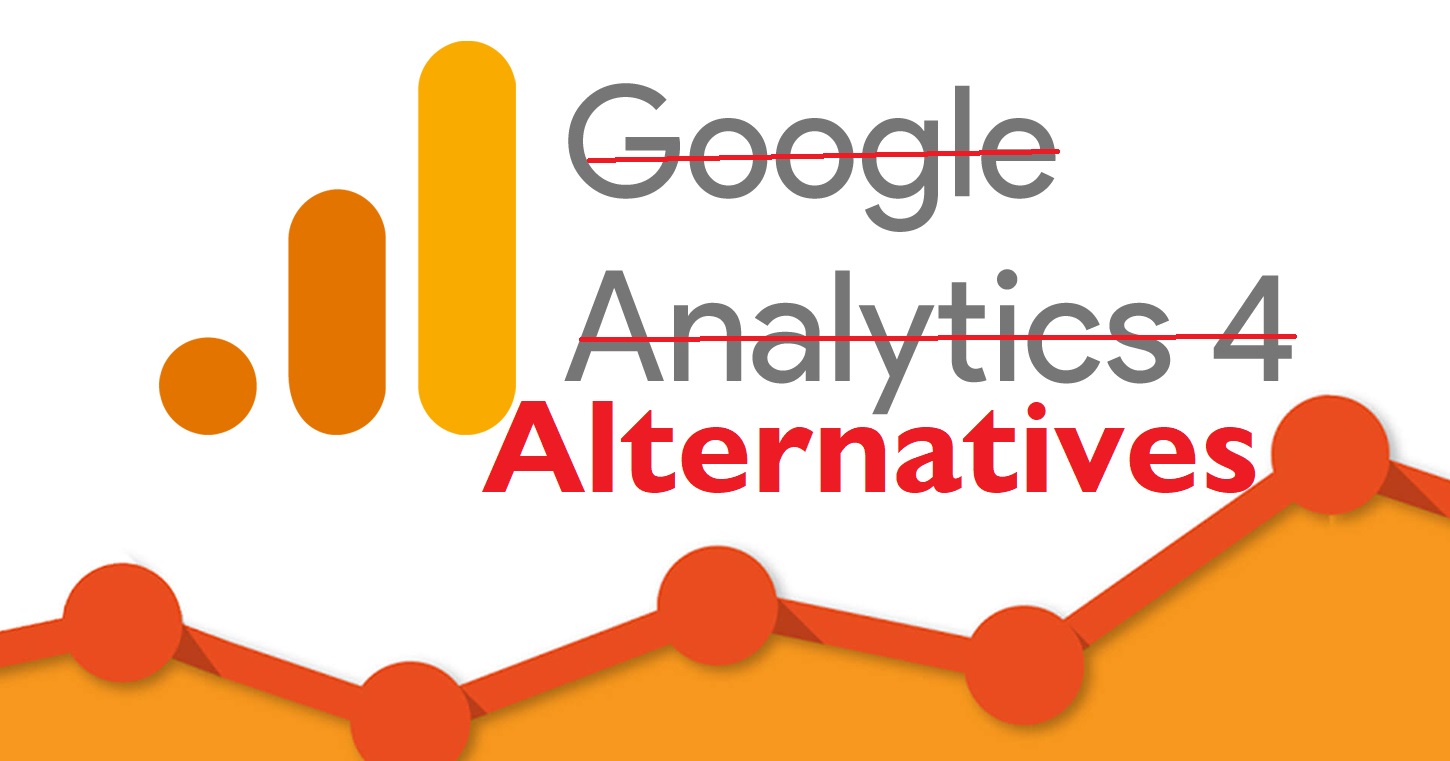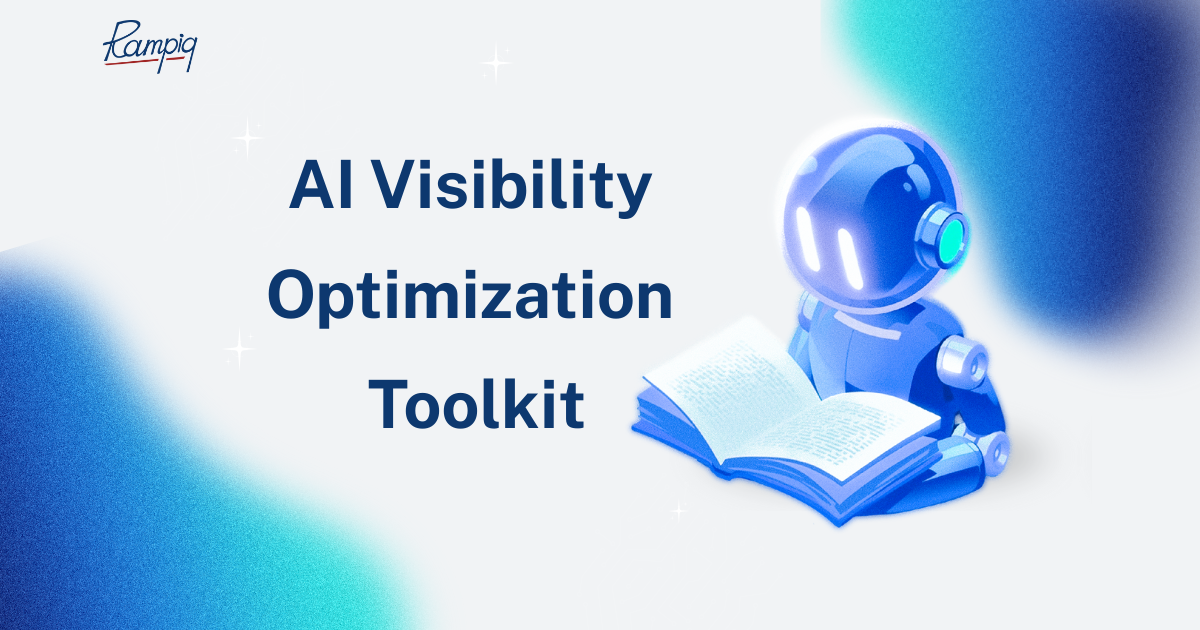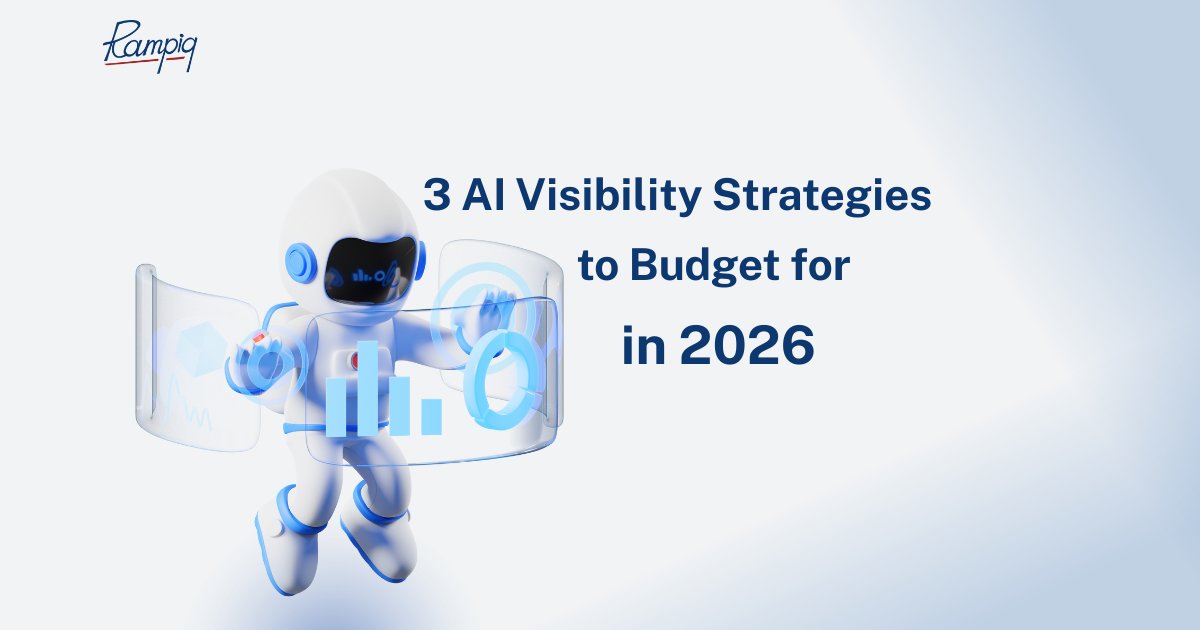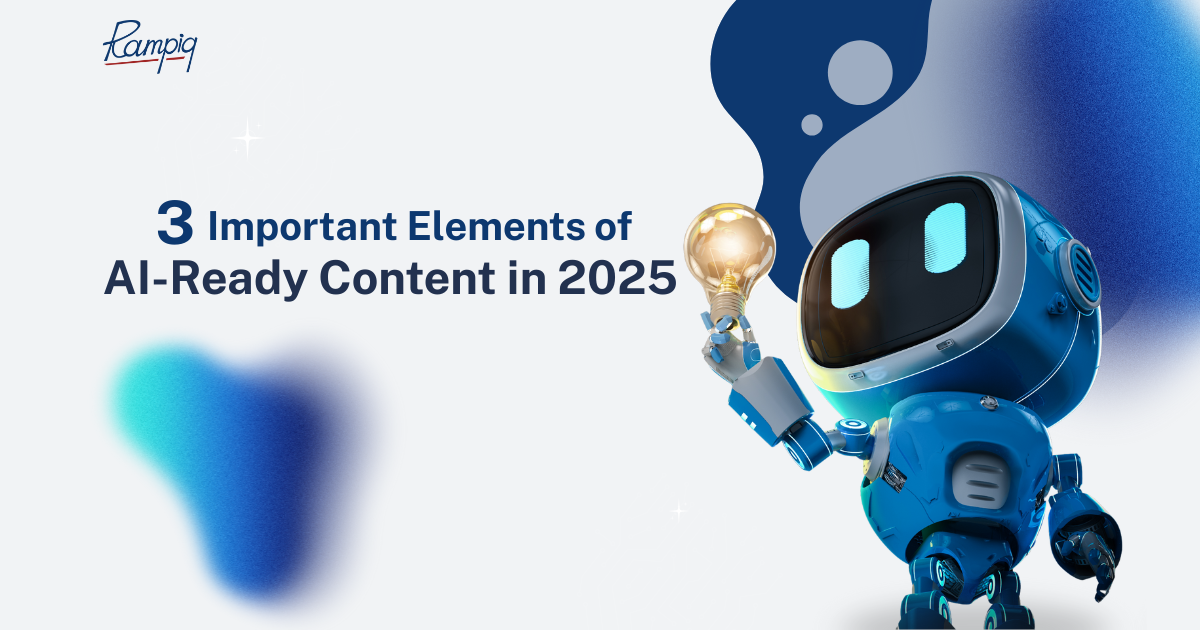Limitations of Google Analytics 4 – Why Marketers Are Switching
First of all, marketers have grown used to the interface of UA, but GA4 looks completely different, and it will be long before the users find their way around. People who are used to the old Google Analytics may find GA4’s interface to be less user-friendly and intuitive than that of the predecessor.
Another factor is that Google seemed to have overlooked one significant aspect – backward compatibility. Historical data import is impossible in GA4 – the data would have to be migrated beforehand and only then imported into GA4. No proper migration support is also quoted as a significant deterrent.
Also, automatically collected events, enhanced measurement events, recommended events, and custom events have data collection limits. Although it’s true you can upgrade to Google Analytics360 and increase the limits, that is a premium option.
Probably the most significant concern about GA4 is its limited GDPR compliance. Many GA4 accounts still require the ongoing use of cookies, which has been declared as a breach of GDPR in some EU countries, such as France, Italy, and Austria. When coupled with no proper data anonymization (GA4 anonymizes IP addresses, but an assigned unique ID still counts as personal data under GDPR), this is a major deterrent for more data-privacy-conscious businesses around the world. Fortunately, Google Analytics 4 is not the only option after you are forced to say farewell to the good old Universal Analytics.
Best GA4 Alternatives at a Glance
If you are looking for a GA4 alternative that offers a different approach to data privacy, needs more features, appreciates regular e-mail reporting or roll-up reports, or needs deeper, more detailed insights or an intuitive, easy-to-search interface, we have a selection of GA4 alternatives.
Read more to find out about such options as Matomo Analytics, Open Web Analytics, Adobe Analytics, Clicky, MixPanel, Fathom Analytics, Snowplow, Woopra, KissMetrics, and more, to pick one that best suits your needs.
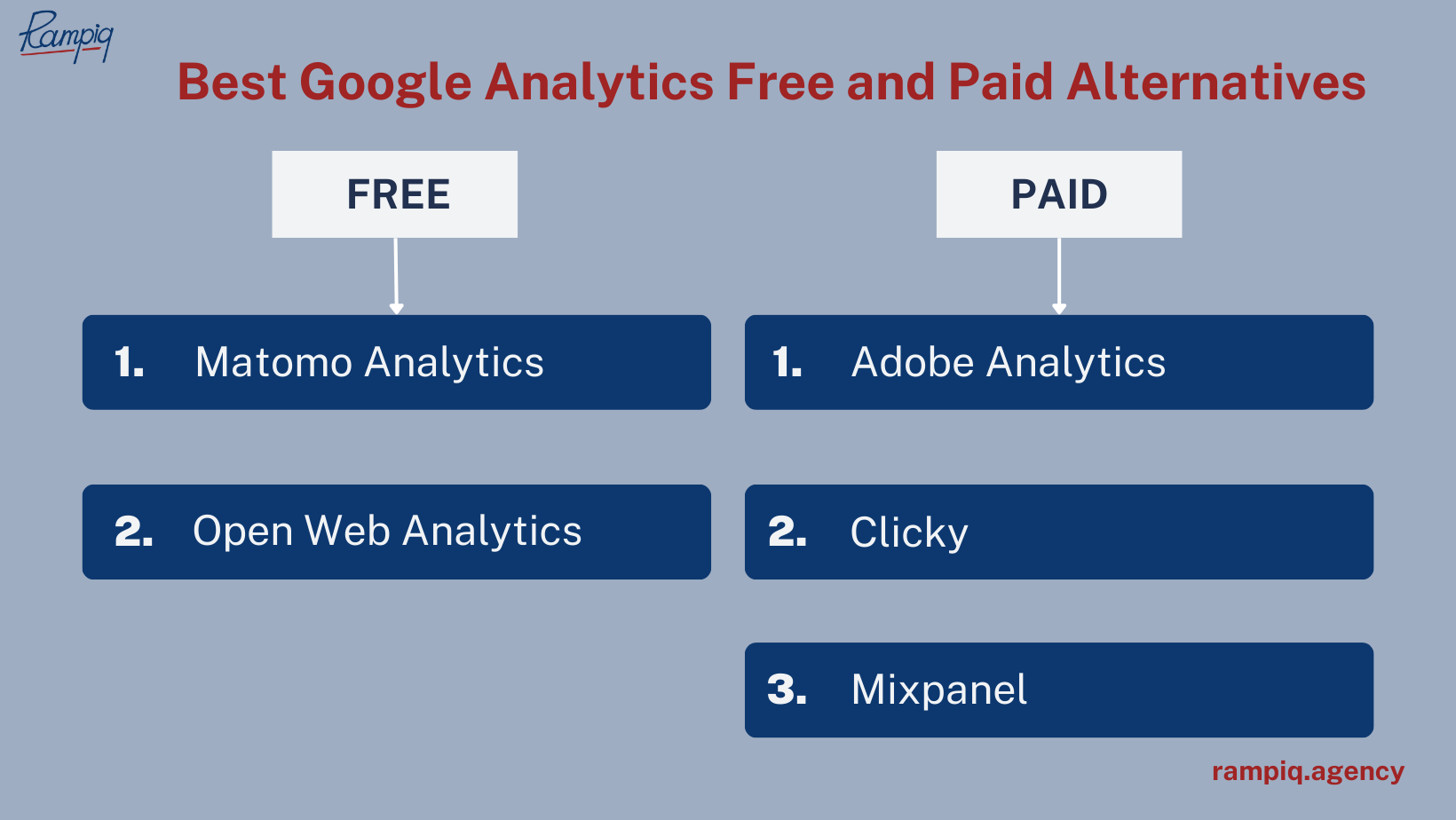
Best Google Analytics Free Alternatives
For those who are committed to using OS software and supporting the online community, we have two options: both are self-hosted, giving you more control over the tool and greater flexibility.
Matomo Analytics
Matomo offers its users a choice between cloud and on-prem installation. This tool is recommended for privacy-focused businesses and those that appreciate complete control over their data. The brand boasts a platform that provides 100% data ownership – the user decides how the data is stored, managed, and deleted.
Matomo claims it is an ‘ethical alternative’ to GA4, and by this they mean they don’t use your data for their own purposes. It will be a perfect solution for companies based in France, Italy, Austria, or one of the other countries where GA4 has been ruled to be in breach of GDPR or CCPA. Self-hosting options ensure data privacy and control.
Regarding Matomo Analytics’ features, with its heatmaps, A/B testing, and user-centric insights, this GA4 alternative caters to the needs of the most demanding business users. It also enables data import directly from GA and claims to offer ongoing support from its experts.
Since this is an open-source solution, by choosing it you rely on the joint efforts of numerous minds and support the constant improvement of the tool. Matomo allows customization and white labeling, taking data and software ownership further than most providers.
On another note, users complain about the outdated layout and slow response to queries. The interface is not very transparent, which is a disappointment since this is also a major complaint about Google Analytics 4.
Open Web Analytics
This tool is good for small to medium-sized businesses and developers who prefer the control and independence granted by self-hosted solutions. With OWA, companies can choose how they analyze the use of their websites and mobile apps.
Similar to Matomo Analytics, Open Web Analytics is also highly customizable and offers complete ownership and control over data. It is fully compliant with GDPR and will satisfy the demands of the most discerning users by providing access to extensive analytical metrics and advanced features not often encountered in Open Source software.
Business owners and marketers will appreciate such features as:
- event tracking,
- goal conversion and e-commerce analytics,
- cross-platform tracking,
- heatmaps,
- detail usage of any web page (including prior and next pages viewed!), and
- the clickstream of anonymized user sessions.
Advanced functionalities serve to determine the loyalty of your visitors. The tool features cookie-based tracking, and IT specialists might appreciate the fact that the OWA wiki contains all end-user and developer documentation. As an Open Source solution, Open Web Analytics comes with extensive help and support provided by its community of authors, users, and contributors.
As an Open Source platform, OWA is not a ready-to-use solution. It might involve some time and funds to customize it to your business needs, and bug fixes take time because you rely on community support.
Best Paid Alternatives to GA4
Those entrepreneurs and business owners who are committed to the idea of premium, proprietary software, might opt for a paid rather than a free Open Source solution. They often argue it is best for security reasons, and has an image-boosting effect.
While the privacy aspect nowadays is arguably nonexistent, because Open Source tools are just as secure and often more transparent, a company may have its own reasons for choosing a paid option. To complete the list of the best Google Analytics alternatives, we have three proprietary options with various advantages.
Adobe Analytics
You may instantly recognize the name, and Adobe Analytics is definitely true to its reputation. It provides the user with actionable insights and fast results. Adobe Analytics is fairly popular and is mostly appreciated by large enterprise-level businesses and data-driven organizations that prioritize user privacy/security, and require advanced analytics and marketing capabilities.
With cookie-based tracking, this tool brings together data from various digital channels and offers a real-time holistic view of your customers. Comprehensive analytics enables informed decisions: with powerful attribution from paid, owned, and earned media, you can manage your investments accordingly.
Another important aspect is that this solution uses generative AI to help you analyze customer journeys – online and offline – and make the most of the extracted data. Use machine learning to produce ad-hoc questions to query the data and quickly extract insights, generate natural language insights to be used for storytelling, and keep abreast of website traffic trends thanks to data visualization.
Extensive enterprise-level support is an extra advantage, and complete with impressive customization options, it makes Adobe one of the premium analytics tools like GA. This one is strongly set in the “Know Your Customer” philosophy – it collects behavioral, transactional, and operational data and aggregates it into a single actionable user profile.
Last but not least, this tool has the option to implement a cookieless strategy, in case cookies are deemed illegal in the future. It’s a great solution for marketers, product owners, and data analysts.
Since this is a tool with an extensive range of features, it will take some time to master. The user interface is not that intuitive, and users have complained about slower loading times because the amount of data to be processed is huge.
Clicky
This cloud-based solution is a good choice for small to medium-sized businesses, bloggers, and e-commerce websites. It offers a range of functionalities, such as real-time analytics, heatmaps or individual visitor tracking, to begin with. Those who are resentful of the new GA4 interface will probably appreciate the user-friendly layout, structure and simplicity of this tool.
As regards the noteworthy features, Clicky comes with customizable dashboards and e-mail reports, so there is something for those marketers and business owners who like to be kept up to date through a more traditional channel. This simple, privacy-friendly tool offers live stats, which is really refreshing, considering that average data processing latency is 24-48 hours with Google Analytics. The ‘Spy’ feature is the ability to detect and block bots, and to track ad-block visitors.
Additionally, you can optionally log more data for security or anti-fraud purposes, and all this is in line with the GDPR provisions. With the functionality of shopping cart tracking and account data stats, this solution is a great choice for all kinds of online stores.
On the minus side, some of the reports provided on the platform are only available for a limited time, which means it’s impossible to track performance over the entire year.
Mixpanel
Mixpanel is recommended for mobile-app-based businesses and product-focused companies. It prioritizes event-based analytics, user-behavior tracking, and retention analysis. The company’s slogan – “From data to decisions” – is highly revealing.
This is a decent GA4 alternative that excels in mapping customer experience – it provides deep insights into user engagement and product performance, which drive informed decisions about restocking and amending the product portfolio. Another thing that makes this tool unique is advanced cohort analysis and funnel analysis for in-depth user segmentation. For example, if you want to target Gen Z, with Mixpanel you can extract the data you need to adjust your products, services or communications to reach the desired target, and then measure your performance using the analytics results.
Mixpanel is one of the most intuitive, user-friendly, and transparent analytics tools suggested as GA4 alternatives. It includes several extra features, such as:
- behavioral messaging and push notifications,
- the possibility to embed reports into your favorite design and productivity tools, such as Figma and Coda, and
- an interactive UI, where you can ask questions to try and solve issues as they appear.
This tool does have its drawbacks, though. A full set of features comes at a considerable price, and with the extensive range of functionalities, there is not enough support. Some features are available for a limited period, and configuration options are hard to follow. It also transpires that the brand relies on schema planning in its data governance, which can be a challenge with large-scale operations.
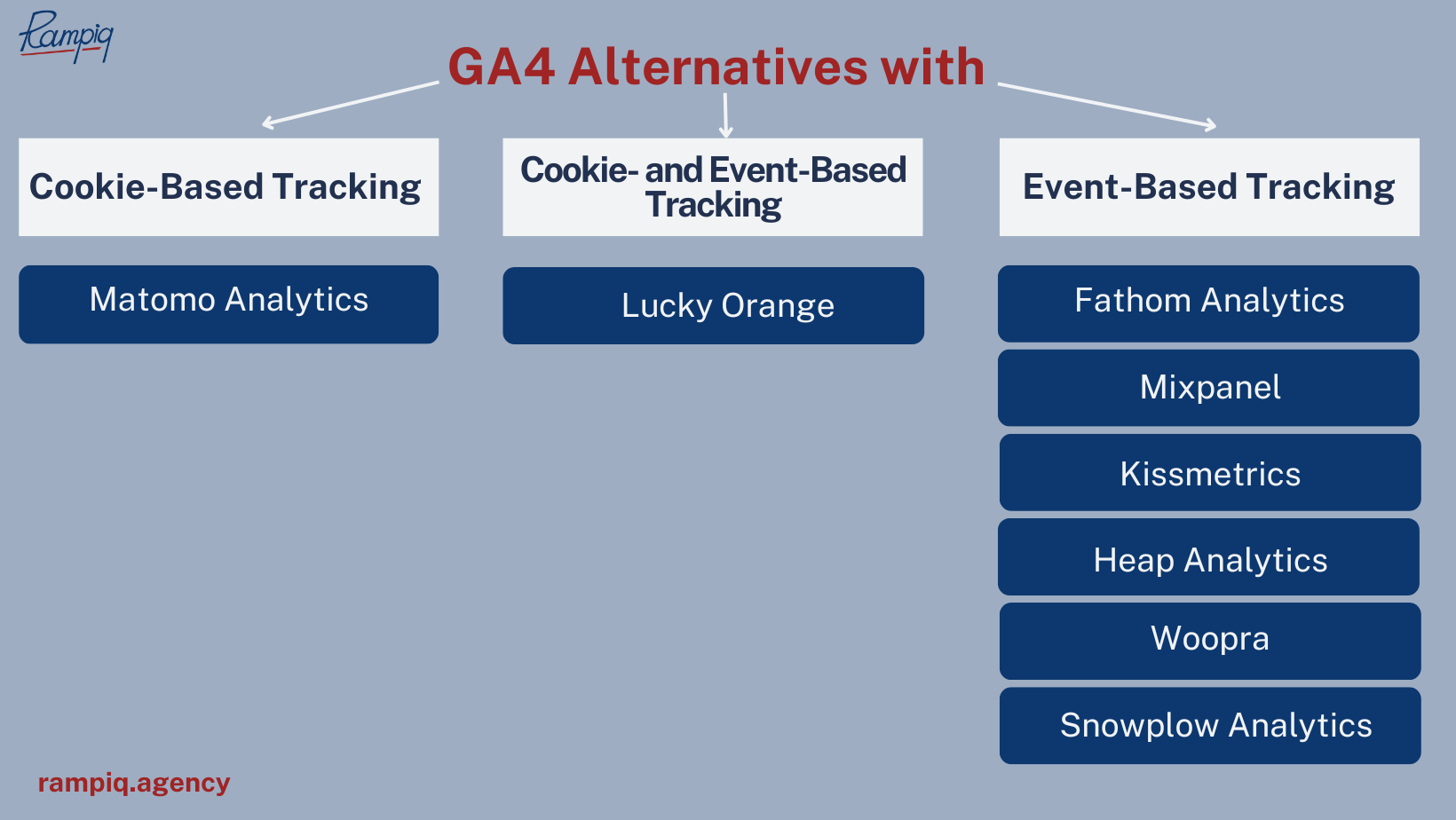
GA4 Alternative with Cookie-Based Tracking
In this category, we present one GA4 alternative with cookie-based tracking. The chief concerns about using cookies refer mainly to third-party cookies. Although cookies were not created with malicious intent in mind, they can be used for a variety of purposes and as such can be a privacy threat.
Matomo Analytics
Matomo uses mainly first-party cookies, which provide such information as e.g. random unique visitor ID, time of the first visit for this user, time of the previous visit for this user, or number of visits for this user. You have the option to disable cookies, of course, or enable third-party cookies.
Matomo can also be customized and configured to track optional information about users and their behavior. Since Matomo prioritizes data ownership and control, you are free to customize data privacy settings. Any data stored by Matomo is never sent to any third-party server. IP Anonymization is a default feature in Matomo, which is good news for users with static IP. An IP address is generally considered personally identifiable data unless at least 2 bytes are anonymized, and this is exactly what Matomo guarantees.
There is one other issue with cookie-based tracking, though. The availability of numerous adblocking extensions means many users have disabled cookies and are counted as new website visitors each time. In this situation, cookie-based tracking may not always be a reliable form of analytics.
GA4 Alternatives with Event-Based Tracking
Event-based analytics tracks the behaviors of users as they engage with your online content – each measurable behavior is classified as an event. Understanding user decisions means you can adjust your own content, products, and services, to meet your prospects’ expectations and ensure a greater return on your investment. Here are a couple of Google Analytics 4 alternatives with event-based tracking.
Fathom Analytics
This cloud-based solution has not been presented yet, and it definitely deserves a mention on our list. It is recommended for privacy-conscious users, bloggers, and small businesses. While it’s not a match to a premium tool like Adobe Analytics, it is one of the simple, clean, and easy-to-understand GA4 alternatives.
Fathom Analytics focuses on privacy with no personal data collection. The brand ensures that all the customers’ EU traffic is routed through European-owned infrastructure and their Canadian company has a GDPR adequacy ruling. This intuitive tool is a single line of code that works with any website, CMR, or framework. The lightweight structure is also better for SEO.
Fathom Analytics offers you the opportunity to save your UA data by importing it into the local tool. Those of you who liked the feeling of being regularly updated will appreciate e-mail reporting, which helps you keep track of your analytics and performance.
There is, however, a downside to using Fathom Analytics. To compare the performance of your websites over time, you need to click on each page separately and record the difference, which makes the whole process time-consuming, especially if you manage a significant number of sites.
Mixpanel
This tool has already been discussed before. It draws on event-based tracking not only to measure what is happening on your website or in your application but also why. Detailed analytics combined with a genuine understanding of your customers’ actions and decisions will help you make informed choices about your future development, to provide the users with targeted added value.
Mixpanel offers an exhaustive inventory of tools and metrics to guide you through the analytics process:
- obtain detailed information about new users and conversion rates,
- monitor and analyze retention,
- see how users convert at every step of their journey,
- observe user engagement, and
- explore the impact of individual campaigns.
Features embedded in the tool are highly customizable and come in a number of variants, so you can find the perfect mix of functionalities that reflect your business needs, and avoid costly mistakes in the process.
Kissmetrics
This platform might be an interesting choice for e-commerce businesses and companies focused on customer lifecycle analysis. The brand boasts a simple, intuitive tool for tracking user behavior, finding bottlenecks, reducing customer churn, and optimizing revenue.
Event-based tracking means every single action is linked to a human behind it, therefore the entire analytics process gains a human dimension. With this user-friendly solution, you can effectively monitor which steps of the customer journey result in conversion. Since Kissmetrics offers customer-centered analytics, you can use it to monitor individual user behavior and lifetime value.
As regards the main features of Kissmetrics analytics, they include A/B testing and engagement metrics. It might also be reassuring to know that the brand is not a newbie in the analytics market – with $10 billion in transaction volume, this acclaimed analytics tool has been one of the industry leaders since 2010!
Although the Kissmetrics tool has a number of advantages, users complain about the complicated interface and insufficient data visualization. Another issue is that upgrading your plan might be costly with this tool.
Heap Analytics
This solution has been designed for businesses that want automatic event tracking with manual code implementation, to maximize control and ownership of the entire process. The tool provides automatic capture of all user interactions across all channels, and the Session Replay functionality offers retroactive analysis, taking you back to the key steps of the customer journey.
The advanced data science layer of the platform continuously screens the available data, including even those events you have so far left untracked, to:
- highlight any hidden friction points,
- help you avoid confirmation bias, and
- ensure your decisions are based on objective, data-driven findings.
This highly targeted, proactive analytics tool is a decent choice for evidence-based business practice.
Heap offers seamless integration of quantitative analysis and qualitative insights to facilitate planning individual steps of the funnel – the feature known as Journey Maps offers a broad view of all possible paths you can take to reach your goal so that you can identify your opportunities and make the most of them.
On the minus side, Heap comes with high-cost support. Another, and probably more important concern, is that it has an aggressive algorithm that filters personally identifiable information, and it only takes one incident to expose potentially sensitive PII. This is a serious deterrent for privacy-concerned businesses from the finance and healthcare sectors.
Woopra
This cloud-based tool might be an interesting choice for businesses seeking a unified view of customer data across multiple touchpoints. It is a brand trusted by industry giants, such as Red Hat and Amazon.
Woopra offers real-time segmentation, behavioral cohorts, and personalized messaging, and there’s more. With numerous integrations, it helps you unify and track synchronized data from your databases and SaaS services. This comprehensive approach effectively drives informed decisions and helps you boost your revenue by optimizing investments and avoiding dead-end streets in your business. The solution is complete with customer profiles and journey tracking across web, mobile, and e-mail interactions.
A drawback is that the user interface looks rather dated. It is pretty difficult to carry out simple tasks, like even downloading complex reports, without the help of the developers. The platform could do with some tutorials or documentation to help users get started.
Snowplow Analytics
Behavioral Data Platform by Snowplow helps you create first-party customer data to drive informed business decisions. The tool is recommended for data-driven businesses that require highly customizable event tracking and data collection. The toolkit offers event data management at scale, which allows businesses to collect and process raw event data. This way you can obtain AI- and BI-ready data and feed them into any warehouse or lake.
With this platform, you can:
- create your own event and entity definitions,
- deploy to your own private cloud to maintain full control and ownership,
- create rich customer profiles with out-of-the-box identity resolution, and
- use all the collected data to drive value even faster than before.
The tool comes with a range of integrations and features, such as measuring and mapping the customer journey, or the ability to predict customer behavior and lifetime value, analyze content, and forecast sales. Understanding the customer lifecycle means you can personalize UX and model your tracking design accordingly. Other advantages of this solution include integration with other analytics tools, and automatic alerts in case of data quality issues.
As for the downsides, the free version of this solution has serious limitations and integration with other tools is complicated. Users also complain that the solution is not intuitive – the configuration is cumbersome and time-consuming.
GA4 Alternative with Cookie- and Event-Based Tracking
On our list there is one alternative to Google Analytics 4 which uses cookies to a limited extent and combines it with event-based tracking. Its key advantages include dynamic heatmapping and user recording.
Lucky Orange
This solution will be appreciated by e-commerce businesses and marketers who focus on conversion optimization. It offers session recordings, heatmaps, and live chat integration. It helps you create a user-friendly environment and a personalized user experience by triggering announcements by behavior.
This customizable tool offers multiple possibilities to build dashboards including all the key metrics to keep tabs on all campaigns and traffic sources. It can be seamlessly integrated with your favorite tools, including Google Analytics. The intuitive format means this platform can be used by sole proprietors as well as large agencies.
Modern marketers will appreciate the detailed insights into the mechanics of online traffic, to see what prevents key segments from converting, and the option to compare the performance of organic and paid campaigns. The tool is fully GDPR-compliant and as such will make a good choice for privacy-sensitive sectors.
On another note, users do not appreciate the chat functionality of Lucky Orange. Also, the solution doesn’t seem to work well with single-page apps and does not have a fully-functional archive – older data is deleted. It was also claimed that the tool could do with a better filter to reduce similar recordings.
Attribution-focused Tools
These are alternatives to Google Analytics 4 that track customer interactions with different marketing channels and assign a value to each touchpoint – this way you can assess the effectiveness of each marketing channel. Essentially, there are four attribution models: single touchpoint models, multi-touchpoint rule-based models, algorithmic or data-driven models and econometric models. In this category, we have two solutions, which can work as GA4 alternatives for your business.
Dreamdata
Dreamdata perfectly organizes available data into a single source of information, without breaking it into disjointed silos. Now you can connect all the loose ends to gain a complete overview of the customer journey.
It measures site engagement with account-based metrics and offers business data segmentation.
Additionally, the tool performs Advanced Impact Analytics and provides cost reporting on ad networks. It is a perfect tool for B2B marketers who want to stay on top and rest assured they make data-driven decisions without roaming in the dark.
The solution is GDPR-compliant and SOC 2 Type II certified, which guarantees secure and responsible data handling. It does rely on the Google Cloud Platform but offers much more than Google Analytics 4 in its current format. As such, it’s a one-stop shop for those who are on the lookout for a comprehensive tracking, transformation, modeling, and orchestration stack.
The main drawbacks include complicated implementation due to the impressive number of features, and some specialist terminology that might be difficult to grasp without the underlying expertise.
Hockeystack
This is an end-to-end solution which will help you connect your ads, website, and CRM so that you can use the complete data to make informed decisions. This attribution tool is relied upon by many business giants, some of whom are mentioned below:
As regards the advantages of dissolution, it is easy to set up: it’s enough to copy the script, paste it to your website and your product, and then connect your tech stack. Now you can track every touchpoint from the first contact to the outcome, and focus on high-intent accounts to boost your business opportunities. You can also collect your LinkedIn impressions and measure the performance of your campaigns.
Other powerful functionalities help you track the entire customer journey and visualize it with no code so that your B2B marketing team can focus on their core activities. Hockeystack nailed down Attribution 2.0 – this means they use software-based and self-reported attribution together, to provide an overall view of the customer experience and track all possible touchpoints.
Last but not least, the solution comes with extensive support – a free expert support Slack channel, and a community ready to answer all your questions. And if that’s not enough, you can try out the interactive demo before you settle for this tool.
How Does GA4 Compare to the Alternatives?
| GA4 Alternative |
Tracking Method |
Best for |
Strengths compared to GA4 |
| Matomo Analytics |
Cookie-based tracking |
Privacy-focused businesses |
Self-hosted option for data privacy and control. Advanced features like heatmaps and user-centric insights. |
| Open Web Analytics |
Cookie-based tracking |
Small to medium-sized businesses |
Complete ownership and control over data. Supports event tracking, goal conversion, and cross-platform tracking. |
| Fathom Analytics |
Cookie-based tracking |
Privacy-conscious individuals |
Privacy-focused with no personal data collection. Simple and clean analytics dashboards. |
| Lucky Orange |
Cookie/Event-based tracking |
E-commerce and conversion optimization |
Session recordings, heatmaps, and live chat integration for user experience improvement. |
| Adobe Analytics |
Paid |
Enterprise-level organizations |
Comprehensive analytics, data visualization, and powerful marketing integrations. |
| Clicky |
Paid |
Small to medium-sized businesses |
Real-time analytics, heatmaps, and individual visitor tracking. |
| Mixpanel |
Event-based tracking |
Mobile app-based businesses |
Event-based analytics, user behavior tracking, and deep insights into user engagement and product performance. |
| Kissmetrics |
Event-based tracking |
E-commerce businesses |
Customer-centric analytics, individual user tracking, and lifetime value analysis. |
| Heap Analytics |
Event-based tracking |
Businesses that want automatic event tracking |
Automatic capture of user interactions and retroactive analysis capabilities. |
| Woopra |
Event-based tracking |
Businesses seeking a unified customer data view |
Customer-centric analytics, real-time segmentation, and cross-channel tracking. |
| Snowplow Analytics |
Event-based tracking |
Data-driven businesses that need highly customizable event tracking |
Event data management at scale, custom event tracking, and integration flexibility. |
| Dreamdata |
Attribution-based tracking |
Businesses that prioritize transparency and privacy |
Account-based metrics, business data segmentation, Advanced Impact Analytics and cost reporting on ad networks. |
| Hockeystack |
Attribution-based tracking |
Modern, security-conscious businesses |
Attribution 2.0., audit logs, rich access controls, 99.9% uptime. |
